Global Site
Displaying present location in the site.
Green Transformation of Data Centers and Energy-Saving Technologies
Vol.18 No.1 May 2025 Special Issue on Green Transformation — The NEC Group’s Environmental InitiativesData centers are the backbone of the IT society. Leveraging years of operational experience, NEC opened the NEC Kanagawa Data Center Phase 2 and NEC Kobe Data Center Phase 3 Buildings in May 2024. This paper focuses on the environmental requirements surrounding data centers and the various initiatives for greening them. Both centers strive for energy efficiency and achieved a design partial Power Usage Effectiveness (pPUE) at the top level of 1.16, which is a primary metric for measuring data center energy efficiency. With rising expectations for AI, this paper also considers the technological trends related to the hosting of GPU servers and other AI-supporting infrastructure, and also presents NEC's vision for the future of data centers.
1. Introduction
Data centers play a vital role in supporting IT infrastructure. After the Great East Japan Earthquake, data centers with facilities that safeguard corporate IT systems have become increasingly important. As power demands grow to meet the needs of AI training and high-performance computing, data centers face the challenges of enhancing efficiency and reducing environmental impact. Addressing these challenges has become an urgent priority for the industry.1) 2)
Building on 40 years of expertise in data center management, NEC has unveiled new facilities: the Kanagawa Data Center Phase 2 Building in Kanagawa Prefecture and the Kobe Data Center Phase 3 Building in Hyogo Prefecture, as shown in Fig. 1 and Fig 2 respectively. These centers are designed to offer exceptional availability, connectivity, and security as well as provide robust support for cloud infrastructures and advanced colocation services to clients. By integrating infrastructure with cloud and colocation services and incorporating automation for a synergistic and optimized management approach, NEC aims to streamline and optimize operations. The centers boast impressive energy efficiency and achieved a Power Usage Effectiveness (PUE) of 1.16, which represents a design partial PUE that is in the highest level in the industry. This enabled us to minimize CO2 emissions. Nonetheless, data centers currently account for 40% of NEC's total energy consumption, and their environmental impact is expected to increase with the rise of Graphic Processing Units (GPU) servers for AI, highlighting the urgency for comprehensive, long-term solutions.
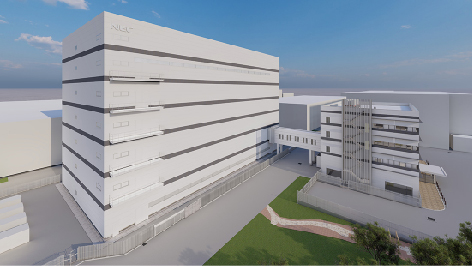
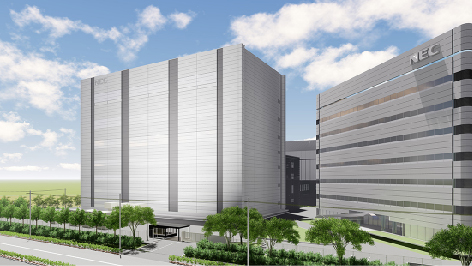
2. Environmental Challenges Facing Data Centers
Addressing the environmental impact of data centers is a key element of NEC's comprehensive environmental commitment. NEC received certification for the Science Based Targets (SBT) initiative's Net-Zero target and is committed to achieving carbon neutrality by 2040. As a member of Renewable Energy 100% (RE100), NEC is also dedicated to increasing the use of renewable energy throughout its operations. To meet these goals, three primary challenges must be tackled:
- (1)Improving energy efficiency in data center infrastructure
- (2)Transitioning to 100% renewable energy
- (3)Enhancing energy efficiency in IT equipment
To achieve efficient operations with minimal reliance on renewable energy, it is essential to first significantly reduce the overall energy consumption of data centers. Although data center administrators can oversee infrastructure components such as cooling systems, they often lack administrative control over the choice and operation of IT equipment. For this reason, targeted strategies are needed to address the substantial energy consumption of IT equipment that accounts for over 80% of a data center's total power usage.
3. Environmental Strategies
3.1 Energy Efficiency in Data Center Infrastructure
Non-IT equipment data center infrastructure consumes energy in several key areas:
- (1)Chiller plants and Heating, Ventilation, and Air Conditioning (HVAC) systems
- (2)Facility management, including lighting for offices and shared spaces, monitoring systems, and security equipment
- (3)Power distribution losses
In this section, we explore innovative design strategies aimed at reducing energy consumption in chiller plants and HVAC systems, which account for the largest share of energy usage in facility operations.
3.1.1 HVAC System
NEC's HVAC system employs a unique design that adapts clean room technology from semiconductor plants as shown in Fig. 3. By utilizing this approach, NEC reduced HVAC power consumption by more than 12% compared to conventional raised floor systems, assuming no underfloor wiring is present.
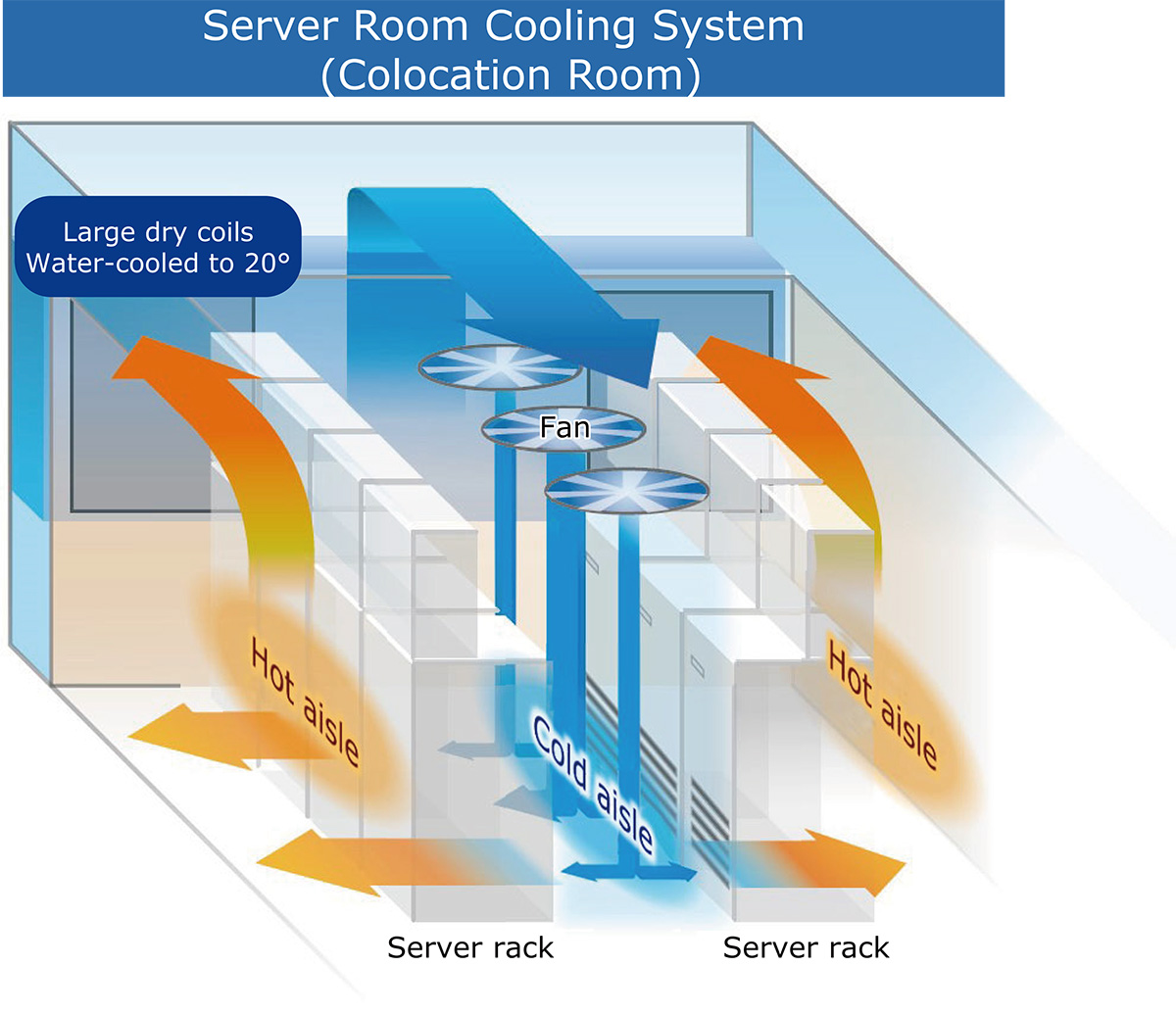
 Click to Enlarge
Click to Enlarge3.1.2 Chiller Plant Method
- (1)Indirect free cooling
For chiller plants, a method known as free cooling uses cold air from outside to indirectly cool the air in the cooling towers to lower the power consumption of chillers. By using high-temperature chilled water at 20°C, the system maximizes the energy harnessed from the outside air. This approach extends the free cooling period by two months compared to a conventional 15°C system and improves the efficiency of power consumption by 28%. - (2)Air-cooled, magnetic bearing chillers
In addition to conventional turbo chillers, advanced high-efficiency, air-cooled chillers have been adopted for chiller plants as shown in Photo 1. Turbo chillers generate chilled water for IT equipment by spraying water on cooling towers and using the process of evaporative cooling to cool the water. In contrast, air-cooled chillers provide chilled water solely through heat exchange with the air, eliminating the need to spray water. A distinctive feature of the newly adopted equipment is the use of magnetic bearings, which leverage magnetism to prevent contact between the bearings and the shaft. As a result, this achieves exceptionally low friction and enables high efficiency. These air-cooled chillers achieve an average annual Coefficient of Performance (COP) of approximately 12, making them exceptionally efficient for air-cooled systems.
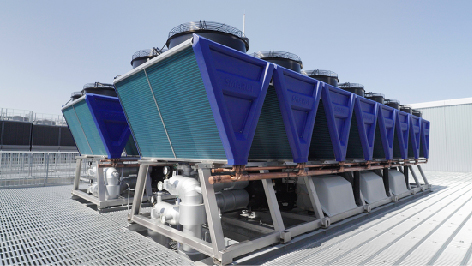
3.2 Adoption of 100% Renewable Energy
Renewable energy can be sourced by various methods. NEC aims to create a green energy portfolio by combining different sources to ensure a stable supply. Although some options are still under consideration and negotiation, they include:
- (1)Onsite power generation
- (2)Onsite power PPAs
- (3)Offsite physical PPAs
- (4)Offsite virtual PPAs
- (5)Procurement from non-fossil certificate markets
- (6)Green certificates
Market-based procurement and virtual Power Purchase Agreements (PPAs) under the Feed-In Premium (FIP) scheme are subject to price fluctuations. Onsite power generation and onsite PPAs are limited by space constraints, thereby restricting the volume of energy that can be generated or procured. Meanwhile, offsite physical PPAs face transmission limitations, meaning energy can typically only be supplied from nearby power plants. Considering these factors, an optimal energy procurement strategy tailored to the specific location and infrastructure of each data center must be devised. Furthermore, compliance with RE100 regulations is essential, and RE100 stipulates that energy cannot be sourced from renewable energy plants older than 15 years or large hydropower plants due to their higher environmental impact. Therefore, it is crucial to procure energy that meets these stringent requirements.
As the demand for energy from IT equipment, especially for AI applications, is expected to surge, urgent measures must be taken to effectively address this growing need.
3.3 Energy Efficiency in IT Equipment
Directly reducing the energy consumption of IT equipment is challenging, because data centers typically do not have administrative control over these devices. However, we believe that effective strategies can be implemented to indirectly encourage reductions in energy consumption. For instance, the Ministry of Economy, Trade and Industry (METI) recommends the measurement and reporting of power usage by colocation clients through its benchmarking system, which can incentivize clients to curb their energy use.
At NEC’s Kanagawa Data Center Phase 2 and Kobe Data Center Phase 3 Buildings, electricity meters that adhere to Japan’s Measurement Act are installed at the rack level to measure usage as shown in Photo 2. NEC also offers a service issuing non-fossil fuel certificates based on actual energy consumption.
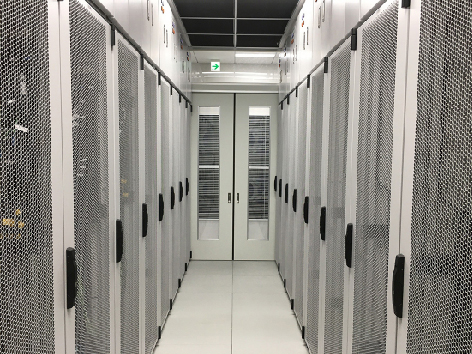
4. Future Outlook
In the near future, the demand for high-load, high-density IT equipment for AI with power needs of 60 kW per rack or more is expected to increase significantly. As the density of such equipment grows, conventional air-based cooling methods become less effective. Consequently, we foresee an increase in IT systems that use chilled water or other cooling liquids to directly cool heat-generating components. Although integrating high-density, liquid-cooled systems with existing cooling infrastructure can be challenging, these systems offer improved efficiency and allow for year-round free cooling. From an environmental standpoint, although the absolute volume of energy consumption increases, these systems are believed to enable more efficient and waste-free operations. Furthermore, as that absolute volume of consumption rises significantly, it is necessary to be thorough when considering how to procure renewable energy and carefully evaluate factors such as location and climate conditions when planning and designing data centers.
At NEC, when installing equipment with a high consumption of power, we contribute to reducing the environmental impact by considering the procurement of renewable energy from the planning stage onwards.
5. Conclusion
The demands on data centers are evolving at a rapid pace. While maintaining the stable operation of existing facilities with high standards of security, accessibility, and efficiency, we are also adopting new technologies to tackle the challenges posed by high-density and high-load operations. Our goal is to address these challenges while also actively reducing the environmental impact. At NEC's data centers, we help enhance societal efficiency through advanced technologies such as AI and cloud services and also actively collaborate with users to achieve environmental sustainability.
References
Author’s Profile
Director
Data Center Service Department
APEC engineer (Electrical)
 Japan Data Center Council: Data Center Facility Standard Version 3.0, June 2024 (Japanese)
Japan Data Center Council: Data Center Facility Standard Version 3.0, June 2024 (Japanese)